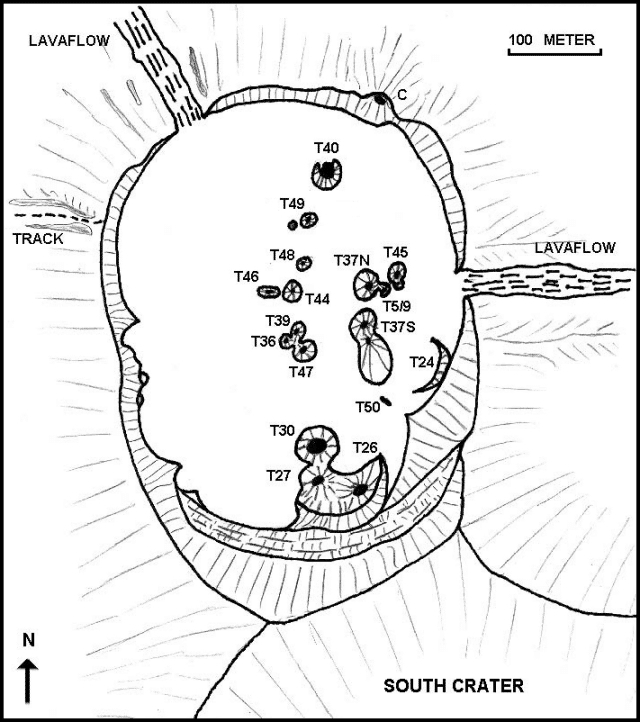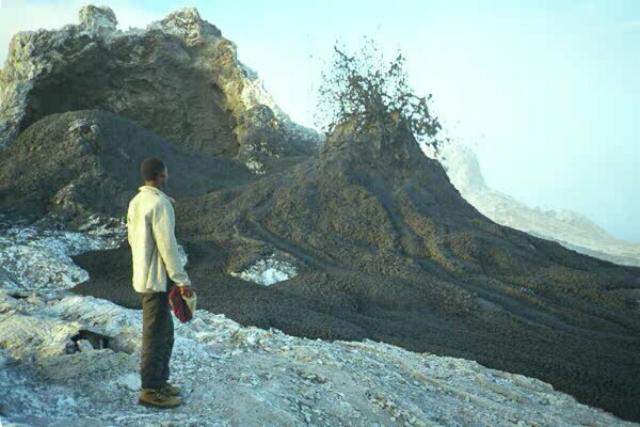Report on Ol Doinyo Lengai (Tanzania) — November 1999
Bulletin of the Global Volcanism Network, vol. 24, no. 11 (November 1999)
Managing Editor: Richard Wunderman.
Ol Doinyo Lengai (Tanzania) Very active hornito in the N part of the crater
Please cite this report as:
Global Volcanism Program, 1999. Report on Ol Doinyo Lengai (Tanzania) (Wunderman, R., ed.). Bulletin of the Global Volcanism Network, 24:11. Smithsonian Institution. https://doi.org/10.5479/si.GVP.BGVN199911-222120
Ol Doinyo Lengai
Tanzania
2.764°S, 35.914°E; summit elev. 2962 m
All times are local (unless otherwise noted)
The following report resulted from a visit to the crater of Ol Doinyo Lengai during 23 July-7 August. Prior to the visit and according to a local source (Burra Ami Gadiye), lava breaching the NW crater rim on 18 July flowed down the flank of the volcano and was visible at night from Ngare Sero village, ~10 km N. When the visitor's crater observations began at 1100 on 23 July, this lava flow from the NW crater rim breach had cooled and was becoming white from weathering, but it was clearly the most recent lava in the crater. Its source was hornito T40 (figure 63) based on comparisons of 1998 and 1999 photographs by C. Weber. From 2 to 6 August, an intermittent lava lake 3 m in diameter also existed inside T37N1 at a depth of 20 m.
 |
Figure 63. Sketch map of the crater at Ol Doinyo Lengai for the period 23 July-7 August 1999. Courtesy of Christoph Weber. |
The conical part of T40 was 85 m around at its base and 12 m tall. The N side of the hornito's cone was walled by a low overhanging rim and its S side was covered by a high half-dome. The hornito also included a large, 6-m-deep crater. A small lava pond at the N end of the crater ejected 16-20 spatters per minute through 24-25 July. Twice on 26 July parts of the half-dome and the cone's summit collapsed into the crater.
During 27-28 July lava gradually rose inside the crater of T40 and formed a 4 x 6 m lake and several ponds. By 29 July the lake was ~12 m long and 7 m wide. In a pattern repeating every 15-20 minutes a surge of fresh lava boiled up from the NE corner of the lake, raising the level by 0.5 m. Lava flowed out of the lake to the NW through a subterranean tunnel but did not escape onto the main crater floor.
Although this pattern persisted for some time, at 1400 on 30 July an abrupt increase in activity produced high lava spatters that fell on the N flank of T40. Fresh lava swept into the lake from the N like breaking ocean waves and strong ground tremor shook the N flank of the cone. This activity continued through 31 July, when the lake rose to ~60 cm below the lowest point along the vent rim. Spatter gradually built up the N wall of the crater by more than 1 m and formed a large hood overhanging the area of most intense degassing.
At 0045 on 1 August, a hole developed in the hornito's new crater wall. Lava escaped and moved N as short aa flows up to 60 cm thick. Lava ceased to escape by 0600 but similar eruptions recurred through 1300 on 2 August. Intense degassing later destroyed the hood covering the N part of the lake, but splashing built a thick covering of spatter on the N flank of the cone and reconstructed the hood. Around 0300 on 3 August a new vent opened low on the NW flank of T40 where the strongest tremor had been during the previous few days. An aa lava flow 20 cm thick moved 73 m NW. By 0800 the eruption had ended and the lake level dropped by 2 m. By 0600 on 4 August the lake temporarily disappeared, leaving a solid crater floor 2.5 m below the rim. Lava reappeared about noon but only occupied a 2 m2 area at the crater's N end; the lava frequently overflowed from the pond and produced many small lava flows that covered most of the hornito's crater floor. At 2345 solid lava covering the new vent on the NW flank of T40 blew off; explosions occurred at a rate of 18-20/minute and constructed a new spatter cone. During repose periods, the activity shifted to the lava lake, creating high spatters that reached the summit of T40. After explosions ended at 0800 on 5 August, the new cone was 3 m tall with a circular summit vent 60 cm in diameter. Lava was bubbling in the vent at a depth of 1 m (figure 64).
At 2000 on 5 August pahoehoe lava flowed rapidly across the NE rim of T40 and moved E for 55 m. At 0645 the next morning, more lava escaped the lake through a hole in the NE rim of T40 and covered much of the previous night's flow. Beginning at 1800 on 6 August the lake repeatedly overflowed the hornito's NE rim, later overflowing the NW rim. Around 0400 on 7 August a hole that opened 1 m below the NE rim of T40 gradually enlarged and drained ~60 m3 of lava from the lake forming an open NE-directed lava channel 60 cm wide. By 0800 on 7 August the hole was 1 m high and 0.5 m wide. When observations ended at 0815, lava was nearing the NE crater wall and subsequent reporting noted that lava never reached the breach in the E crater rim, stopping short by 70 m. It was later learned from Guillaume Delpech, a French geology student, that during his visit to T40 on 9 August, the lava lake level inside the hornito varied between 3 and 4 m below its rim. No lava flowed outside of T40 and the spatter cone was inactive.
Christoph Weber made temperature measurements using a digital thermometer (TM 914C with a stab feeler standard K-type) during the crater visit (table 2). The instrument was used in the 0-1200 Celsius mode, taking readings by inserting the feeler 15 cm into the lava. Calibration was made by the Delta-T method: values are ± 6°C in the 0-750°C range. Most values shown were maxima recorded from a series of at least five repeat measurements.
Table 2. Temperature estimates from 60 measurements at Ol Doinyo Lengai made during 23 July-7 August 1999. See text for method used. Courtesy of Christoph Weber.
| Date | Location | Estimated temperature (°C) |
| 28 Aug 1999 | T40 lava lake | 529 |
| 01 Sep 1999 | Pahoehoe (in open channel, 3 m below the lava lake) | 519 |
| 01 Sep 1999 | End of a 60-cm-thick aa flow | 516 |
| 28 Aug 1999 | Fumarole near base of T49 | 82 |
Activity during early September 1999. Bruno Hermier visited the crater in early September and made the following observations. On the afternoon of 6 September only the northernmost hornito (T40) seemed to be active. A lava flow was estimated to be about two days old. Two E-W fissures cross the western half of the crater emitting fumaroles that deposit sulfur. The fissures are perpendicular to the N-S trend of the volcano and radiate from the hornitos. On 7 September at 0900 some spatter came from the top of the 7-m-high T40 hornito. The spatter became larger, creating a pond of lava visible at the top of the hornito. It began to overflow on all sides of the hornito for 15 minutes before the lava level dropped. This cycle repeated until 1300, after which only a low hissing noise was perceptible. Interestingly, a foam filled the hornito. The spatter that splashed on the sides of the chimney and the fluid that overflowed the rim instantaneously lost 75 percent of their volume as gas exsolved. The remaining 25 percent cooled or flowed as black carbonatite. The extremely fluid flows (consistency of oil or hot tar) were only a few centimeters thick, but extended 50-100 m. No additional activity was seen through the evening of 9 September.
Geological Summary. The symmetrical Ol Doinyo Lengai is the only volcano known to have erupted carbonatite tephras and lavas in historical time. The prominent stratovolcano, known to the Maasai as "The Mountain of God," rises abruptly above the broad plain south of Lake Natron in the Gregory Rift Valley. The cone-building stage ended about 15,000 years ago and was followed by periodic ejection of natrocarbonatitic and nephelinite tephra during the Holocene. Historical eruptions have consisted of smaller tephra ejections and emission of numerous natrocarbonatitic lava flows on the floor of the summit crater and occasionally down the upper flanks. The depth and morphology of the northern crater have changed dramatically during the course of historical eruptions, ranging from steep crater walls about 200 m deep in the mid-20th century to shallow platforms mostly filling the crater. Long-term lava effusion in the summit crater beginning in 1983 had by the turn of the century mostly filled the northern crater; by late 1998 lava had begun overflowing the crater rim.
Information Contacts: Frederick Belton, 3555 Philsdale Ave., Memphis, TN 38111 USA (URL: http://oldoinyolengai.pbworks.com/); Celia Nyamweru, Department of Anthropology, St. Lawrence University, Canton, NY 13617 USA (URL: http://blogs.stlawu.edu/lengai/); Christoph Weber, Friesenstrasse 20, 42107 Wuppertal, Germany; Bruno Hermier, France.


